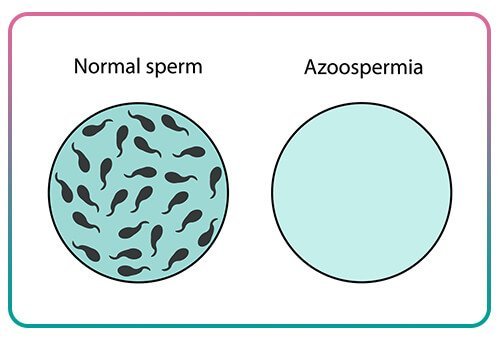Azoospermia is a medical condition where a man’s semen contains no sperm. This condition can be a significant cause of male infertility, as sperm is essential for fertilizing a woman’s egg during conception. Azoospermia affects about 1% of all men and 10-15% of infertile men. Understanding the causes, symptoms, diagnosis, and treatment options for azoospermia is essential for those dealing with infertility concerns.
Types of Azoospermia
Azoospermia can be classified into two main types based on the underlying cause:
-
Obstructive Azoospermia (OA): In obstructive azoospermia, sperm is produced in the testes but is blocked from being ejaculated due to an obstruction in the reproductive tract. This blockage can occur in the vas deferens (the tubes that carry sperm from the testes to the urethra), epididymis, or ejaculatory ducts.
-
Non-Obstructive Azoospermia (NOA): Non-obstructive azoospermia occurs when there is a problem with sperm production itself. In this case, the testes are not producing enough or any sperm due to issues such as hormonal imbalances, genetic factors, or damage to the testes.
Causes of Azoospermia
The causes of azoospermia vary depending on whether it is obstructive or non-obstructive:
Causes of Obstructive Azoospermia:
- Congenital Absence of the Vas Deferens (CAVD): This genetic condition results in men being born without the vas deferens, which prevents sperm from reaching the semen.
- Vasectomy: A surgical procedure where the vas deferens is cut, intentionally blocking sperm from entering the semen. This is typically a form of contraception.
- Infections: Infections like epididymitis can cause scarring, which blocks sperm flow.
- Ejaculatory Duct Obstruction: Blockages in the ducts that allow sperm to mix with semen can result in azoospermia.
Causes of Non-Obstructive Azoospermia:
- Genetic Disorders: Conditions like Klinefelter syndrome can affect sperm production.
- Hormonal Imbalances: Issues with hormones like testosterone, follicle-stimulating hormone (FSH), and luteinizing hormone (LH) can disrupt sperm production.
- Testicular Damage: Injury to the testes from trauma, surgery, or radiation can affect their ability to produce sperm.
- Varicocele: Enlarged veins in the scrotum can interfere with sperm production.
- Cancer Treatments: Chemotherapy or radiation therapy for cancer can damage the testes and affect sperm production.
Symptoms of Azoospermia
Azoospermia often presents no obvious symptoms aside from the inability to conceive a child. Since men with this condition typically ejaculate semen, they may not realize there is no sperm present without a fertility test.
However, if azoospermia is related to an underlying issue, some symptoms might include:
- Low libido: If hormonal imbalances are present.
- Small or swollen testicles: Particularly if varicocele or infections are the cause.
- Ejaculatory pain or discomfort: In cases of obstruction or infection.
Diagnosis of Azoospermia
Diagnosing azoospermia typically involves several steps:
-
Semen Analysis: The first step is a semen analysis, where a sample of semen is examined under a microscope to check for the presence of sperm. If no sperm is found, further testing is required to determine whether the azoospermia is obstructive or non-obstructive.
-
Blood Tests: Blood tests are used to measure hormone levels, including testosterone, FSH, and LH, which can help determine if there is a hormonal imbalance affecting sperm production.
-
Genetic Testing: Genetic testing may be performed to check for conditions like Klinefelter syndrome or other chromosomal abnormalities that could affect fertility.
-
Ultrasound: A scrotal ultrasound can help identify physical blockages or abnormalities in the reproductive system, such as a varicocele or testicular damage.
-
Testicular Biopsy: In cases of non-obstructive azoospermia, a testicular biopsy may be performed to see if sperm is being produced within the testes but not making it into the semen.
Treatment Options for Azoospermia
The treatment for azoospermia depends on whether it is obstructive or non-obstructive and the underlying cause:
Treatment for Obstructive Azoospermia:
- Surgical Repair: Blockages in the vas deferens, epididymis, or ejaculatory ducts can often be repaired surgically to restore the flow of sperm.
- Vasectomy Reversal: For men who have had a vasectomy, a vasectomy reversal can reconnect the vas deferens and restore fertility.
- Sperm Retrieval Techniques: In cases where surgery isn’t feasible, techniques like testicular sperm extraction (TESE) or percutaneous epididymal sperm aspiration (PESA) can retrieve sperm directly from the testicles or epididymis for use in assisted reproductive techniques like in vitro fertilization (IVF).
Treatment for Non-Obstructive Azoospermia:
- Hormonal Therapy: If hormonal imbalances are the cause, medications may be prescribed to stimulate sperm production.
- Lifestyle Changes: In some cases, changes in lifestyle, such as weight loss, avoiding toxins, or improving diet, can help restore sperm production.
- Sperm Retrieval and Assisted Reproduction: In cases where sperm production is very low, sperm retrieval methods combined with IVF may be used to help a couple conceive.
Conclusion
Azoospermia is a significant factor in male infertility, but it’s important to note that many men with this condition still have options for conceiving. From surgical treatments to assisted reproductive technologies, the path to fatherhood is not closed for men with azoospermia. If you or your partner suspect infertility, it’s crucial to consult a healthcare provider for a proper diagnosis and to explore available treatment options.

















